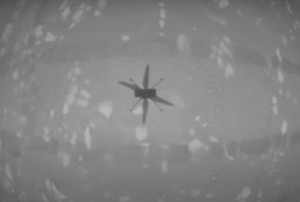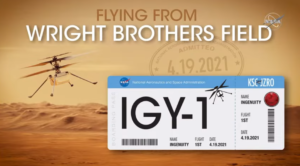Ingenuity Flies! Another First for NASA
NASA’s Ingenuity helicopter made its first flight on Mars this morning, the first powered flight on another planet. According to data received at the Jet Propulsion Laboratory about 6:30 am ET, the tiny rotorcraft lifted off, ascended to about 10 feet, hovered, and landed as planned. A second flight could take place as soon as Thursday. President Biden was among those praising today’s achievement.
Engineering data and images both arrived at JPL this morning, while more will be coming over the next hours and days. But the first image left no doubt that the helicopter was airborne. Taken by a camera on the helicopter itself looking directly downward, it shows its own shadow on the surface of Mars.

That was quickly followed by a video taken by a camera on the Perseverance rover parked 64 meters (211 feet) away. Ingenuity arrived on Mars in the “belly” of Perseverance and was protected by it until the two were separated to execute these flights.
You wouldn’t believe what I just saw.
More images and video to come…#MarsHelicopterhttps://t.co/PLapgbHeZU pic.twitter.com/mbiOGx4tJZ
— NASA’s Perseverance Mars Rover (@NASAPersevere) April 19, 2021
Data confirmed the helicopter lifted off at 3:34 am ET (12:33 Local Mean Solar Time on Mars), ascended to 3 meters (10 feet), hovered and turned, descended, and landed, a total of 39.1 seconds duration. The entire flight was autonomous. The round-trip travel time for a signal between Earth and Mars is about 11 minutes so it cannot be controlled in real time.
The 1.8 kilogram (4 pound) helicopter is a technology demonstration, not part of the prime mission for the Perseverance rover. NASA allocated only one month for these tests before Perseverance gets on with its scientific investigation of the Martian surface.
NASA hopes to have as many as four more flights of Ingenuity in the remaining two weeks of that month.

At a post-flight press conference, Ingenuity project manager MiMi Aung outlined plans for the next two. The second, which could happen as soon as Thursday, will ascend to 5 meters (16 feet) instead of 3 meters and move sideways 2 meters (6.5 feet) and back before landing. On the third flight, it will again rise to 5 meters, but translate further — 50 meters (164 feet) out and back — before landing.
Details of flights four and five will not be set until after the next two, but Aung wants to test the vehicle to its limits. “I care about going really far and fast.” She’s hoping to reach a distance of as far as 600 meters and “we don’t care which direction. … We really want to push the distance and the speed.”
Perseverance landed in Jezero Crater, which scientists believe once was a lake at the end of a river. Life as we know it requires water, so it may have been habitable for microbial organisms 3.5 billion years ago. Perseverance will look for signs of that ancient life as it travels towards what appears to be the river delta.
Asked if Ingenuity, on its final flight, might be sent in that direction so Perseverance can meet up with it again and take photos, Aung said that discussion is yet to be had with Perseverance program manger Ken Farley. Her team is happy to fly in any direction as long as they get to go far and fast.
NASA compares Ingenuity’s first powered flight on another planet to the 1903 flight of the Wright Brothers Flyer at Kitty Hawk, NC. A piece of fabric from that airplane is aboard Ingenuity and today NASA named the area where the tests are being conducted Wright Brothers Field.
 Ingenuity’s chief pilot, Håvard Grip, announced that the International Civil Aviation Organization (ICAO) has presented NASA and the Federal Aviation Administration with an official ICAO designator — IGY, call-sign Ingenuity — with the location JZRO for Jezero Crater. (KSC presumably refers to NASA’s Kennedy Space Center, next door to Cape Canaveral Air Force Station (CCAFS), the launch site for the Atlas V rocket that sent Perseverance and Ingenuity to Mars. Perseverance/Ingenuity were flown to KSC for several months of final preparations before being transferred to CCAFS for launch.)
Ingenuity’s chief pilot, Håvard Grip, announced that the International Civil Aviation Organization (ICAO) has presented NASA and the Federal Aviation Administration with an official ICAO designator — IGY, call-sign Ingenuity — with the location JZRO for Jezero Crater. (KSC presumably refers to NASA’s Kennedy Space Center, next door to Cape Canaveral Air Force Station (CCAFS), the launch site for the Atlas V rocket that sent Perseverance and Ingenuity to Mars. Perseverance/Ingenuity were flown to KSC for several months of final preparations before being transferred to CCAFS for launch.)
Noting these ICAO designators are used by pilots in their logbooks, Grip held up a brand new logbook: The Nominal Pilot’s Logbook for Planets and Moons.

NASA’s next powered flight on another planetary body will be the Dragonfly mission to Saturn’s moon Titan.
President Biden was paying attention and offered his own accolades in a tweet that showed him standing next to a model of Ingenuity.
Today, President Biden joined NASA as the Ingenuity Mars Helicopter took off from the surface of Mars. In a historic feat, the helicopter became the first aircraft to fly on a planet beyond Earth. pic.twitter.com/rYFuVcmzbF
— The White House (@WhiteHouse) April 19, 2021
Today, the Ingenuity Mars Helicopter achieved liftoff — becoming the first aircraft to fly on another planet. NASA proved once again that with relentless determination and the power of America’s best minds, anything is possible. pic.twitter.com/elC4KPgSOL
— President Biden (@POTUS) April 19, 2021
White House Press Secretary Jen Psaki also gave NASA and Ingenuity a shout-out at today’s White House press conference.
Today, we congratulate the men and women of NASA and the Jet Propulsion Laboratory for yet again making history in outer space. The space agency’s aptly named “Ingenuity” helicopter lifted off of Mars early this morning, performed the first-ever powered flight on a world beyond Earth. And this brief flight now paves the way for more extensive exploration down the road. Future Red Planet missions could include choppers as — as scouts or data collectors. Very exciting.
This article has been updated throughout.
User Comments
SpacePolicyOnline.com has the right (but not the obligation) to monitor the comments and to remove any materials it deems inappropriate. We do not post comments that include links to other websites since we have no control over that content nor can we verify the security of such links.